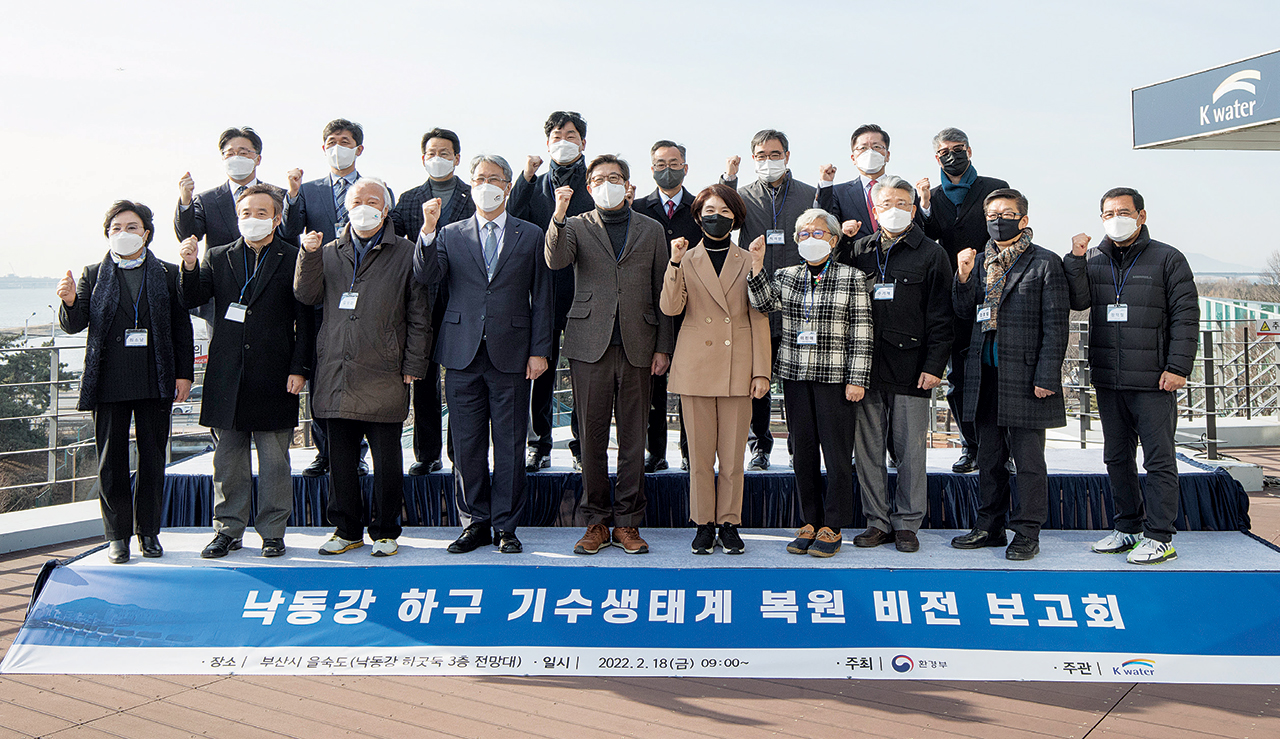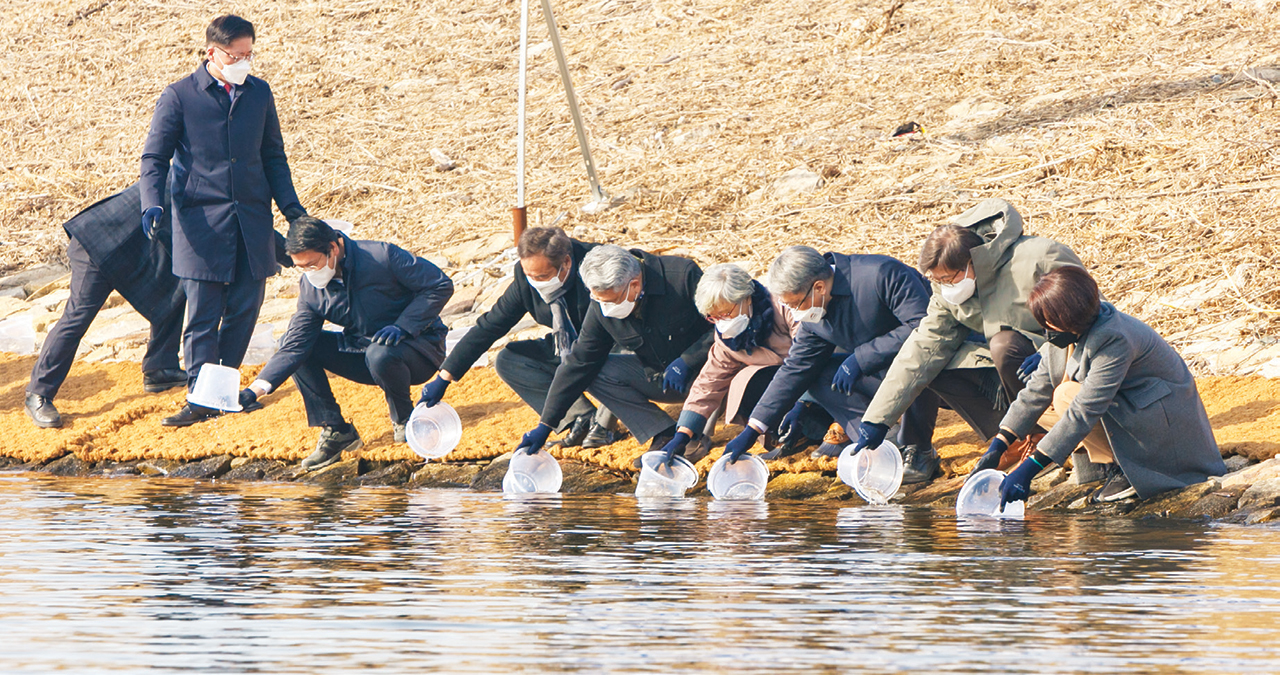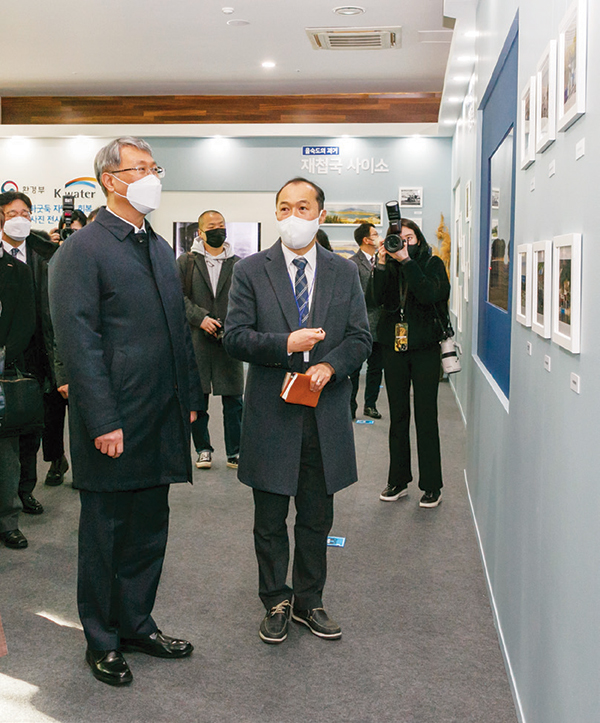
- Water, Nature and Humankind
- K-water Focus ①
-
The encounter between
river and seawater opens
the way to coexistenceHolding of a briefing session on the vision for the restoration of the Nakdonggang River estuarine ecosystem
- Written by. Choi Hang-jwa
- Photos by. Kim Beom-ki
- A new era is dawning at the Nakdonggang River. For the first time since the construction of the Nakdonggang estuary bank in 1987, its sluice gate has been opened, bringing together river and sea and opening a waterway of coexistence between people and nature.


Opening of the sluice gate of the Nakdonggang River estuary bank for the first time in 35years
On February 18, 2022, a “briefing session on the vision for the restoration of the Nakdonggang River estuarine ecosystem” was held by the Ministry of Environment at the Nakdonggang Estuary Bank Observatory on Eulsukdo Island, Busan Metropolitan City, attended by Minister of Environment Han Jeong-ae, Busan Mayor Park Heong-joon, CEO of K-water Park Jae-hyun, and Civilian Chairperson of the Nakdonggang River Basin Water Management Commission Lee Jin-ae.
The session consisted in sharing the achievements of and vision for the “Nakdonggang River estuary, where a healthy ecology and happy life coexist,” and the opening of the sluice gate to allow seawater to flow into the river for the first time this year.
The participants watched in real time a video filmed by drone and CCTV images of an influx of seawater into the upstream area of the estuary bank during the spring tide, when the seawater level is higher than that of the river, and released some young sweet-fish as part of the ecological restoration scheme. The Nakdonggang River estuary provides a natural habitat for diverse species and is a major habitat for migratory birds in Korea, and also has great ecological and economic value. After the construction of the Nakdonggang estuary bank in 1987, however, the number of fish species and migratory birds declined dramatically, resulting in damage to the estuary’s biodiversity and ecological value. Therefore, the Ministry of Environment and K-water have been striving to restore the estuarine ecosystem. Since 2017, the government has been conducting the Trial Opening of the Nakdonggang River Estuary Bank as a national project, and it launched a study on stable water supply and the restoration of estuarine ecosystems in 2018. As a result of the trial opening of the bank from 2019 to 2021, estuarine fish species such as eel and sea bass have been found in the upstream area of the bank, confirming the possibility of ecological restoration. With the opening of the estuary bank, the Nakdonggang River estuary will take its first steps toward maintaining its original functions, such as securing the water supply and preventing damages caused by excess salinity, and restoring its estuarine ecosystems.
President Moon Jae-in delivered a congratulatory video message, saying, “The path to coexistence that is created together with the Nakdonggang River will make our lives healthier and richer.”


K-water will endeavor to restore the
Nakdonggang River estuarine
ecosystem with high-tech water
management technology and make
it a global success story far beyond
Korea.

A pioneering case of the restoration of an estuarine ecosystem
The Ministry of Environment plans to carry out an ecological restoration project based on the Nakdonggang River Estuarine Ecosystem Restoration Plan, which was decided by the Nakdonggang River Basin Water Management Commission on February 9, 2022.
First, a stable brackish water area will be built within 15km of the estuary bank in order to restore the estuarine ecosystem of the upstream area of the bank, and the water quality and ecosystem will be monitored closely for any changes. In addition, the monitoring of changes in the salinity of rivers, soil, and underground water, caused by the inflow of seawater, will be strengthened to prevent saline damage, and efforts will also be made to improve the environment around the west Nakdonggang River basin.
Moreover, the achievements of restoration of the estuarine ecosystem, such as the vitalization of eco-tourism at the mouth of the Nakdonggang River, will be shared with the local community, and the plans will be developed in such a way that local citizens can actually feel the benefits. To this end, the sluice gate will be opened at every spring tide when the seawater level rises. In this era of climate change, estuaries are regarded as natural breakwaters and as excellent carbon sinks. The restoration of the ecosystem of the Nakdonggang River estuary will serve as a model for the opening of other estuary banks and reservoirs along the Four Major Rivers (Hangang, Nakdonggang, Geumgang, and Yeongsangang). Indeed, the restoration of the estuarine ecosystem of the Nakdonggang River is expected to become a pioneering case for the whole world.

